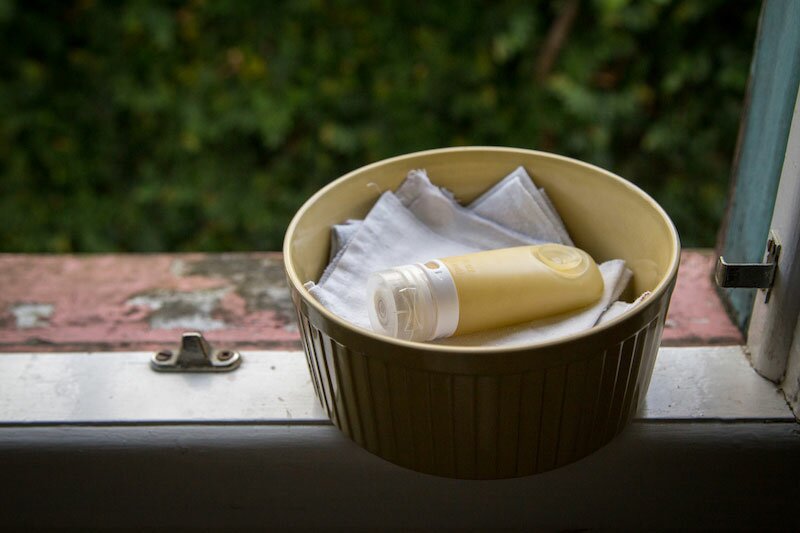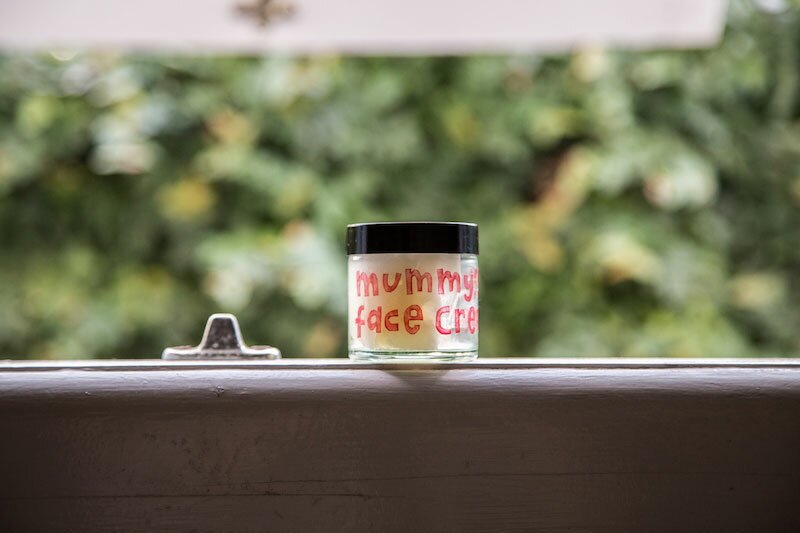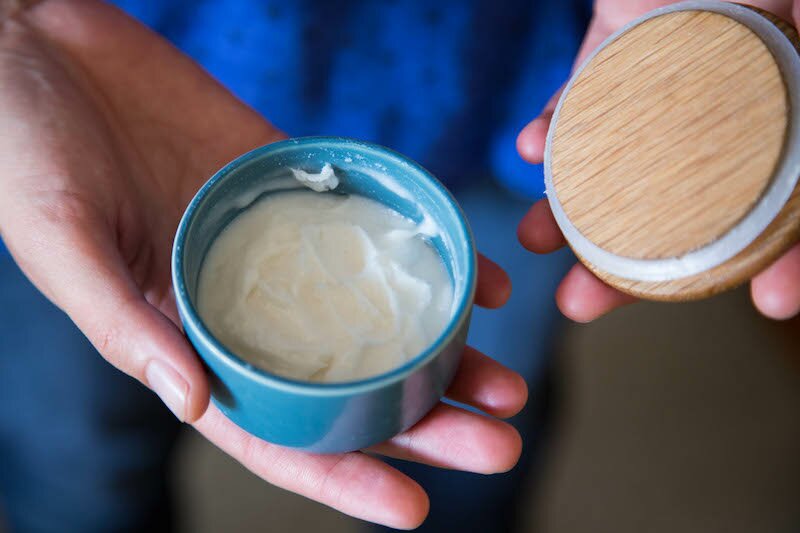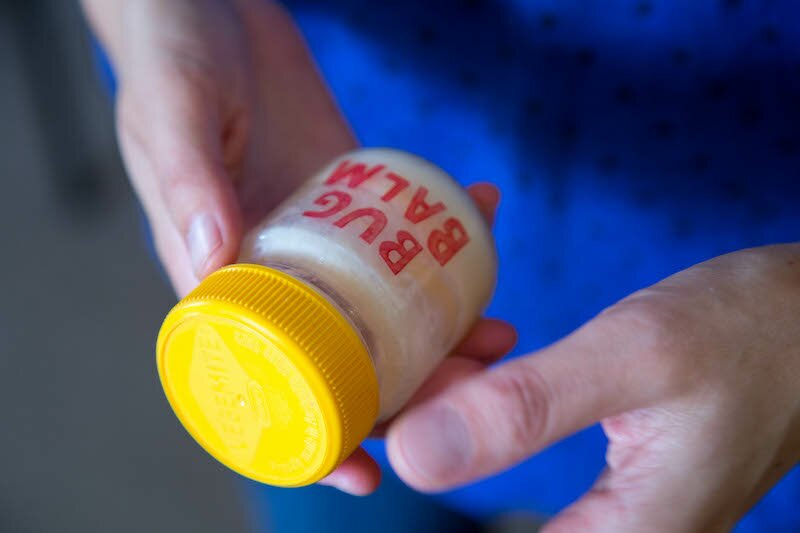I now make all our toiletries myself. By toiletries, I mean lotions and potions like face cream, body cream, deodorant, insect repellent, sun screen, and nappy balm (we call it bum balm!). While there are many commercially made eco-friendly, cruelty-free products available these days, I don’t buy them because in general, I find them hideously expensive. That, and often such products are packaged in small amounts in plastic packaging. If you don’t make these products yourself too, then I will assume that you imagine I spend many hours preparing each one, with a whole apothecary of ingredients, but I assure you that is not the case at all!
In actual fact, preparing all of the above takes very little time at all – it takes about 15 minutes to make the sunscreen and I only do it once a year – and only a small number of ingredients is required. Common ingredients to face cream, body cream, deodorant, insect repellent, sunscreen, and nappy balm are virgin unrefined coconut oil and/or shea butter, plus essential oils of your choice. They require little effort to combine, because you actually don’t want to heat the ingredients any more than is necessary to mix them. I always use a double boiler arrangement to allow for slow, controlled heating on our gas stove. To keep dishes to a minimum, I mix each in the jar I intend to store them in, and then the sun screen and nappy balm get transferred to a super-awesome refillable silicone squeezy tube by humangear, called the GoToob. (BTW, I now sell 3-packs of GoToobs in my shop, yay!)

Coconut oil, which is the base ingredient for all these things, is a liquid at 24°C+ but below that it is solid and can get quite hard. What that means is in winter your cream will have a different consistency from summer. In fact, a successful summer recipe can be pretty hard to work with in winter (keeping in mind it all melts when it makes contact with your skin), so you have to be prepared to tweak a recipe by, for example, adding a bit of a liquid oil like olive oil in winter, or adding a bit more shea butter in summer. I certainly don’t consider this to be a deal-breaker though, as it’s no problem to melt and tweak something that turns out a bit hard or a bit soft for my liking. It’s worth it to know that what you’re rubbing onto your skin would be safe to eat.
If you’re interested in having a go yourself, here are the recipes I use, with acknowledgements where I have taken the recipe from someone else.
FACE CREAM
1 part shea butter
1/2 part coconut oil
1/2 part apricot oil (or similar; sweet almond oil, avocado oil, jojoba oil are all wonderful to your skin!)
A few drops of essential oils – my favourite are lavender and rose absolute because they are so gentle, calming, and they smell beautiful!
If you use a tablespoon of shea butter, that means you’ll end up with 2 tablespoons of face cream. Much as I love the idea of using raw, unrefined shea butter, I actually prefer the texture of refined shea butter in my face cream and deodorant. Refined shea butter doesn’t smell so strong either, so it’s nice to use for something you want to scent with your essential oils. As I mentioned before, I just melt these ingredients in a double boiler type arrangement (pot of water on stove, glass jar sits in water, heat only enough to melt ingredients). Essential oils prefer not to be heated, so take your mixture off the heat and let it cool for a bit before you add the oils. Remember the skin on your face is very delicate so be careful with essential oils as you don’t want to irritate your skin!
I don’t want my face to get too dry, so I use this cream after washing my face with tepid water and then spritzing with toner (my recipe: 1/8 raw apple cider vinegar, 7/8 rose water). I rub the cream onto wet skin.

BODY CREAM
I just use a mix of unrefined shea butter and coconut oil. That’s it.
DEODORANT
This really works. But keep in mind that if you’ve been using aluminium anti-perspirant until now, you will have a detox period. I don’t understand the science of it, but all I know is that I absolutely reeked for a good few weeks after I stopped using anti-perspirant. I have also found that recipes with corn starch were really irritating to my skin, so I only use arrowroot powder now (aka tapioca powder in NZ), and if you have very sensitive skin you could consider reducing the baking soda even more. Please note that you only need a teeny tiny amount per armpit; I don’t even use the equivalent mass of a pea!
3 parts coconut oil
2 parts shea butter
2 parts baking soda
2 parts arrowroot powder
Essential oils (I like to use lavender and tea tree oils)
Melt coconut oil and shea butter to combine. Remove from heat and add baking soda, arrowroot powder, and essential oils – I use lavender and tea tree oils for their bacteria-fighting properties, but also because they are gentle enough to use neat on your skin. I find that the powders settle on the bottom unless I chill the mixture and stir it all up again. The cute little dish with wooden lid is from Freedom Furniture; it’s the perfect size and shape for deodorant!

INSECT REPELLENT
To be honest, we haven’t really tested this one very much. We’ve used it a few times, but we actually prefer to stay away from mosquitoes altogether or just cover up. This is the recipe we used: Non-toxic-bug-repellent-recipe-with-coconut-oil and at the very least it’s moisturising and smells nice! I keep it in a (glass) vegemite jar.

SUNSCREEN
This sunscreen is amazing and it is all our whole family uses in summer. Admittedly, it leaves your skin with a faint white tinge, but I don’t really mind that and the husband and kids certainly couldn’t care less! It does need to be applied generously and frequently in a New Zealand summer, but only as much as ordinary sunscreen should too. I can make 250g for around $15 – that’s enough to last our whole family for a summer. We also practise commonsense sun care too; as in, we use hats and stay under shade cover during the hottest part of the day.
Here is a link to Scratchmommy’s sunscreen recipe.
NAPPY BALM
I have two recipes to share with you. The first one I used for baby Stella, who wore cloth nappies and had no issues with nappy rash.
1/4C shea butter
1/4C coconut oil
1 Tbsp beeswax (chopped up finely)
optional: few drops essential oil, eg. chamomile
Add a bit of liquid oil in cooler months – extra virgin olive oil is great
The second I use for baby Daniel, who had a bout of nappy rash when he was a newborn. It worked so well that I’ve continued to use it. This one isn’t suitable for cloth nappies because it contains zinc oxide, which will make your cloth nappy waterproof over time!
1/4C coconut oil
1/4C shea butter
1 Tbsp beeswax (chopped up finely)
2 Tbsp bentonite clay
1 Tbsp zinc oxide (non-nano)
1 Tbsp extra virgin olive oil
For both recipes, you heat the beeswax first in a double boiler arrangement until it is liquid. Then add the shea butter and coconut oil and heat only enough to melt them and mix. Take the mixture off the heat before adding the remaining ingredients, and stir thoroughly. Note that bentonite clay should not come in contact with metal; I stir all my lotions and potions with a wooden chopstick and, of course, this balm is prepared in a glass jar with plastic lid.
It really is possible to have gorgeous skin using only edible ingredients. This is something worth considering, not only in terms of how they are absorbed or rejected by our bodies, but also in terms of their environmental impact during production, processing, and disposal. Making your own toiletries also means you can invest in reusable, decorative containers such as glass jars and ceramic dishes, and reduce your plastic footprint noticeably, especially over the long term. It doesn’t require a great investment of time or energy, and in fact it can save huge amounts of money. All you need to do is get organised!
Hi, I am new to this but want to give it a go.
Where do you get the Shea Butter and coconut oil from? I could buy online but is there a shop that has them?
Many thanks
Erin
Hi Erin,
I buy mine online from purenature.co.nz. But if you live in Hamilton I could probably give you a bit of shea butter so you can try before buying it? Coconut oil you can get from Bin Inn or any health/wholefoods store – like Village Organics or Whole Heart. Look for raw virgin coconut oil for the best antimicrobial etc properties – although if you hate the smell of coconuts you could buy the deodorised kind; I guess it’s just more processed and not as pure?
Thanks so much Esther, really appreciated your reply!
No problem! Just so you know, some people find coconut oil quite drying in the long term so try it while being open to the possibility it may not be right for you. I’m now trying not to moisturise so much, so that my skin can find its own balance – at the moment I’m just using sweet almond oil, and I use the face cream only for dry patches or days. Please feel free to share your experiences, good or bad!
Hi there, just discovered you blog and love it! I do have a question though regarding your face cream … you mentioned I don’t have to add shea butter? Is that correct? Also do you think if I use half of the coconut in the hardened form and the other half in the liquid coconut oil form would that help to keep it more “liquid” ? Have you tried this by any chance? Where do you purchase your shea butter? thanks heaps!
Hi there, I’m so sorry I didn’t reply to your questions sooner! Your comment got sent to the spam bin (?) and I only found it by accident so I’m not sure how long you’ve been waiting… Anyway, in answer to your question, you could just use straight coconut oil on your face if you wanted to. But it’s the shea butter that makes it nice and creamy, while the coconut oil is …well, oily! When you say ‘liquid coconut oil’ do you mean fractionated coconut oil? I’ve never used it but I assume it would work. Apricot, almond, avocado oils are all much lighter than coconut oil, so they seem to absorb more readily into the skin. I buy my shea butter (both refined and raw) from a trademe seller called “beautyquip”. Have had excellent service from them so far! I hope this helps!